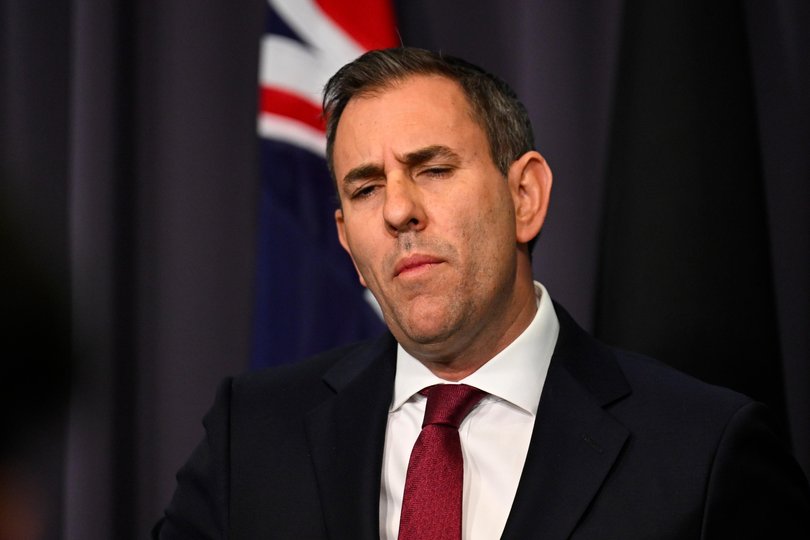JACKSON HEWETT: Reserve Rate relief pushed to at least August, as Michele Bullock joins global peers in fear

Reserve Bank Governor Michele Bullock has joined her global peers in adopting caution in keeping rates on hold at 3.85 per cent.
The timid response has shocked a market that had almost universally pencilled in a 0.25 per cent rate cut in the face of moderating inflation and a flaccid economy.
Six of the nine interest rate policy Board members voted in favour of no change, the first time the RBA has published a breakdown.
Sign up to The Nightly's newsletters.
Get the first look at the digital newspaper, curated daily stories and breaking headlines delivered to your inbox.
By continuing you agree to our Terms and Privacy Policy.The Governor refused to reveal who voted for what, but we do know three called for a cut.
“The decision today was about was about timing rather than direction,” Ms Bullock told reporters.
The lay-down misere that never came delivered fresh misery to mortgage holders hoping for relief, and to the Treasurer too.
He was hoping for an extra kick for his victory lap on inflation, but had to settle for the consolation prize.
“We’ve made substantial and sustained progress in the fight against inflation... That’s why interest rates have already been cut twice in the last five months.”
But he didn’t hide the fact that today’s hold would be a disappointment to many. “Millions of Australians were desperately hoping for more rate relief,” he said. “This decision has come as a surprise to the market and to almost every economist who’s expressed a view.”
Instead, the Treasurer got a reminder that his productivity roundtable needs to come up with the goods.
The RBA called out growing unit labour costs its monetary policy statement, yet another indicator of an economy that seems incapable of getting more output from its workforce.
“Productivity has been slowing, and it was slowing even before the COVID pandemic. It’s been all over the place during the pandemic for various reasons, but essentially it hasn’t gone anywhere in years,” Governor Bullock said.
If output per worker isn’t improving, it becomes harder to deliver real wage gains without fuelling inflation. Ms Bullock made clear that lifting productivity is essential for sustained, non-inflationary growth. “I think it’s really good that government and the Treasurer have latched on to productivity as being a really important thing that we’ve got to get on top of,” she said.
Data dependent
Inflation remains the Bank’s primary concern, and although prices are now safely inside the RBA’s target band of between 2 and 3 per cent, the Board felt it needed one more quarterly reading to ensure it is there sustainably.
If the trajectory remains, August’s meeting - just five weeks away - is the next candidate for a rate cut.
By then the Bank will have June quarter inflation but for now it wants to be “cautious and careful”.
The reliance on quarterly data threw up a new challenge for the Treasurer. Ms Bullock lamented the fact the Bank relied on only “four readings a year”, making it “very difficult… to get an idea of momentum of inflation.”
The Treasurer acknowledged the paucity of data was holding the Bank back, and said new work by the Australian Bureau of Statistics would bring the data into line with global peers.
“Before long, we will have very robust, very reliable monthly inflation figures as robust and reliable as the quarterly figures. And that will help not just the Reserve Bank make its decisions, but more broadly inform our economic considerations as well,” he said.
Trump’s wildcard
While the Governor was adamant the decision was based on domestic considerations, no one can escape the spectre of a global economy thrown into trade turmoil.
Ms Bullock made clear that uncertainty around international trade policy, particularly the evolving tariff situation, was high on the agenda.
“For those people who wanted to ease, it was a little bit more concern about the downside risks, particularly on the international side,” she said, referring to the split vote among Board members.
Board members would have woken up to news of 25 per cent tariffs on key Australian trading partners, but Ms Bullock acknowledged things had improved on the previous meeting when the world was staring down the barrel of a full-blown trade war, including tit-for-tat tariffs between the US and China that could have reached as high as 145 per cent.
“Everyone’s saying, ‘oh, things aren’t as bad anymore’ (but) they’re still much, much worse than they were prior to April 2,” she said, referencing former US President Donald Trump’s so-called ‘Liberation Day.’
“Trade barriers are going to be much, much higher. World trade is going to be impacted,” she said, although her hope was Australia’s exposure would be limited compared to other nations.
“We’re not going to be anywhere near as badly impacted as some countries, because we’re not as directly linked to the United States, and our fortunes are much more linked to China. And so that’s why a lot depends on what happens there,” Ms Bullock said.

Treasurer Jim Chalmers backed that assessment, saying the international environment was now “the main thing that shapes our choices as a government.” He warned that Trump’s tariffs were “bad for the US, bad for Australia, and bad for the global economy,” with potential impacts not just on local industry, but on overall demand and investment confidence.
Dr Chalmers said his job was to make the economy “more resilient in the face of that uncertainty, make our economy more productive… and also try and make our budget more sustainable.”
Governor Bullock has ammunition to react more aggressively in the face of a threat to global growth, though she denied the Bank cut rates in order to keep its powder dry.
“That’s not the motivation for this decision,” Ms Bullock said, although she did note that compared to COVID, when interest rates were already at record lows, this time the Bank was working from a much higher base.
“We’ve got room to move… If something external comes, then we can react.”
But by keeping rates on hold, the RBA risks prolonging weak growth and delaying the recovery in household spending and business investment, with AMP’s Shane Oliver warning it could necessitate “more aggressive rate cuts down the track” if inflation slips below target.
While economists were wrong on this call, they are sticking by their forecasts for more cuts down the track, with a forecast 1 per cent reduction across four increments in August, November, February and the middle of next year.

